György Klapka
György (Móric) Klapka, also known in German as Georg Klapka[1] (7 April 1820 – 17 May 1892) was a Hungarian general. He was one of the most important Hungarian generals of the Hungarian War of Independence of 1848-1849, politician, member of the Hungarian Parliament, and deputy War Minister.
General György Klapka | |
|---|---|
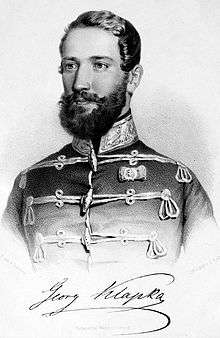 György Klapka | |
| Minister of War (deputy of Artúr Görgei) | |
| In office 7 May 1849 – 21 May 1849 | |
| Prime Minister | Bertalan Szemere |
| Preceded by | Lázár Mészáros |
| Succeeded by | Lajos Aulich |
| Personal details | |
| Born | György Klapka 6 April 1820 Temesvár, Kingdom of Hungary, Austrian Empire (today Timișoara, Romania) |
| Died | 17 May 1892 (aged 72) Budapest, Austria-Hungary |
| Nationality | Hungarian |
| Spouse(s) | Inez d'Arboin |
| Children | György Ernő Márta |
| Awards | 2d Class Hungarian Military Decoration |
| Military service | |
| Allegiance | |
| Branch/service | Army |
| Years of service | 1848-1849 |
| Rank | General |
| Battles/wars | Battle of Tarcal Battle of Bodrogkeresztúr Battle of Tokaj Battle of Hidasnémeti Battle of Pétervásár Battle of Kápolna Battle of Egerfarmos Battle of Tápióbicske Battle of Isaszeg Battle of Nagysalló First Battle of Komárom Siege of Buda Battle of Zsigárd Battle of Pered Second Battle of Komárom Third Battle of Komárom Fourth Battle of Komárom Battle of Hetény |
Early life
Klapka was born at Temesvár, Kingdom of Hungary on 6 April 1820 in a German-speaking family of Moravian origin. His ancestors migrated there from Moravia during the reign of Joseph II (1780-1790) his grandfather founding military pharmacies during the Austro-Turkish War of 1787–1791.[2] In the following decades the families prestige grew, and György Klapka's father, József Klapka, became the mayor of Temesvár for nearly 15 years, being elected for two times deputy in the Hungarian Diet, being later ennobled by the king.[2] His mother was Júlia Kehrer.[3]
Despite of his Moravian origin Klapka considered himself a Hungarian.[4] He made his education at the Roman Catholic secondary schools from Kecskemét and Szeged, then he studied in the military school of Karánsebes.[4] His father sent him to Vienna where he served in the Hungarian Nobiliary Royal Bodyguards (Magyar királyi nemesi testőrség), then in the Guards of Vienna, where he became friend with Artúr Görgei.[5] He was an artillery Lieutenant in 1847, when he retired, and returned to Hungary.[5] Here he was sent as lieutenant to the Border Region Division, but soon he disarmed.[6] In 1847 he thought to go to India and to become an officer in the army of one of the Indian kings, but hearing the news about the revolution from Paris from February 1848 he decided to remain in Hungary.[2]
His military career in the Hungarian War of Independence
Before becoming a general
After the victory, on 15 March, of the Hungarian Revolution of 1848, Klapka volunteered in the Hungarian army, and he was conscripted as Captain.[6] In May 1848 he was appointed by Batthyány Government with two Hungarian officers to go to Kolozsvár and in the Székely Land to find out if Transylvania want to reunite with Hungary, and to measure how many from the Székely border guard units can be sent to Hungary. On 13 June he is appointed as a Captain to the 16 Hungarian Battalion in Veszprém. Starting with August he joins the Hungarian military operations in Bácska (Southern Hungary) against the Serbian insurgents.[4]
On 25 September he is sent to be the temporary director of the fortification works of the fortress of Komárom, called the Gibraltar of the Danube. During that time he prevented Wilhelm Mertz, the constable of the fortress, to deliver it in the hands of the Habsburgs, and played a role in forcing Mertz and the officers loyals to the Habsburgs, to leave Komárom, securing this very important stronghold for Hungary.[2] From 16 October 1848 Klapka supervised also the fortification works from Pozsony.[4] During that time, as the commander of the concentrated Hungarian national guards, he participate in the military operations against the Austrian troops led by Balthasar von Simunich which broke into Hungary from Moravia.[4]
On 13 November he is appointed chief of general staff of the Bánság army corps, and together with general Antal Vetter, he elaborates a plan to crush the Serbian insurgency, but this plan fails because its weak execution by the main commander of the military operations: general Ernő Kiss.[4] In the end of December 1848 he works in the general staff section of the Hungarian Ministry of Defence.[4]
When in December 1848 the main Austrian imperial troops led by Field Marshal Alfred I, Prince of Windisch-Grätz attacked Hungary, he is appointed as Major in the Hungarian army, by 9 January 1849 he is already a Colonel.[5] Together with his chief Antal Vetter he elaborates the plan of retreating the main Hungarian troops behind the Tisza river, and becomes the commander of the Upper Tisza Corps (Felső-tiszai hadtest).[4]


Before this the Upper Tisza Corps was led by the Minister of War General Lázár Mészáros, who was defeated by the Austrian troops led by Lieutenant-General Franz Schlik in the Battle of Kassa.[7] Klapka took over these beaten troops in January 1849, reorganized them, and beat Schlik in three consecutive battles at Tarcal (20 January), Bodrogkeresztúr (23 January), and Tokaj (31 January).[4] Thanks to these victories Klapka held the Hungarian defensive line along the Tisza river, and won precious time for the Hungarian commandment to organize the counter-attack against Windisch-Grätz imperial troops.[5] From 29 January 1849 he is under the command of Lieutenant-General Henryk Dembiński the main commander of the Hungarian armies.[4] After their victory at 5 February 1849 in the Battle of Branyiszkó, the Upper Danube Corps led by Artúr Görgei approached to the Tisza river from North-West, menacing, together with Klapka's corps, to encircle and destroy Schlik's army.[8] Understanding the importance of this chance, Klapka tried to convince Dembiński, to attack from the South Schlik's corps, but the latter refused, ordering Klapka to retreat.[4] This wrong decision of the main commander enabled Schlik to escape the danger, and to retreat.[4] Klapka defeated him again on 8 February at Hidasnémeti, but the Austrian general was able to retreat towards West, joining the main imperial troops led by Windisch-Grätz.[5]
Klapka participated at 26–27 February in the Battle of Kápolna, commanding the right wing of the Hungarian army at Verpelét.[4] The battle was lost because of Dembiński's poor army leading and indecision. After Dembiński's order of retreat, at 1 March Klapka fought successful rearguard actions against the Austrian corps led by Ladislaus von Wrbna at Egerfarmos.[4]
At 3 March he joins the revolt at Tiszafüred of the Hungarian officers dissatisfied with Dembiński's leadership, and force him to resign, supporting Görgei's election to the main commandment.[4]
For his victories against Schlik he receives the 2d Class Hungarian Military Decoration.[4]
General and deputy War Minister
At 28 March, only 29, he received the rank of General.[5]
Klapka elaborated the plan of the Spring Campaign of the Hungarian army, which will bring in the end of May, after a series of victories, the liberation of almost all Hungary from the Austrian armies. The plans main purpose was to distract the attention of the Austrian commanders with the attack from the North of the VII Corps, while the other three corps (I, II, III) had to march undetected from South and to attack from the flank the main Austrian troops stationed at Gödöllő.[4]
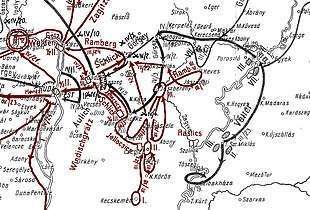
But unfortunately Klapka was the one who, unwillingly revealed the plan to the enemy, as it follows. Initially the victory of the Hungarian VII Corps led by András Gáspár against Schlik in the Battle of Hatvan at 2 April, deceived Windisch-Grätz to think that the attack of the Hungarian forces will come from that direction. But the failed attack of Klapka's I corps against the Austrian I Corps led by Josip Jelačić in the first phase of the Battle of Tápióbicske (he sent his troops in the city without scouting before that, to see if any enemy troops are in there, thus his troops were ambushed by an enemy infantry and a cavalry brigade),[9] forced the III corps led by János Damjanich to intervene, and to turn the tide of the battle - which could become a serious defeat for the Hungarians - in a victory, made the Austrian Field-Marshal suspicious, that the main Hungarian attack could come from other directions, and not from where he expected that.
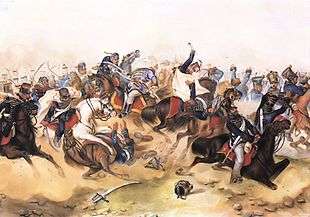
But Jelačić's report, who, because of his vanity, wrote to Windisch-Grätz that his troops won the battle of Tápióbicske, deceived him, to think that the Croatian general was attacked only by minor Hungarian forces, so he still was not sure from where to expect the enemies attack. Furthermore, Windisch-Grätz was informed about the attack of a Hungarian detachment, on 24 March against Losonc, which took prisoner half of the 500-600 strong Austrian detachment, making him to think that important Hungarian troops will attack also from the North-East.[10]
But Klapka's attack made Windisch-Grätz aware of a danger coming from South, and this can be considered his error.[11]
In the Battle of Isaszeg from 6 April, the first decisive battle of the Spring Campaign, after initial successes, Klapka's I Corps were pushed back by Jelačić's superior forces, which made Klapka to waver, and to think seriously to retreat from the battlefield, letting Damjanich's III Corps alone, but the arrival of Görgei, and his order to resist at all costs, then the arrival of the II Corps led by Lajos Aulich, convinced him to remain and fight. At the end of the battle Klapka's I corps charge chased the enemy from Isaszeg and brought the victory for the Hungarians.[12] The fluctuating behavior of Klapka during the battle showed that despite of being a good strategist, creating good operation plans, which enabled, in the Spring Campaign, to defeat the superior imperial troops (55,000 Austrians against 47,500 Hungarians),[13] he could be hesitating in their execution. During the battle of Isaszeg Damjanich criticized Klapka of being too timorous and sensible to the complaints of his soldiers, instead of being resolute and determined, a quality necessary for every successful general.[12] Luckily the main commander of Army of the Upper Danube (Feldunai Hadsereg) was Görgei, who was the most able Hungarian general to carry out Klapka's plans, and he led the army in the best way, being able to take quickly the correct decisions after short thinking, being very determined in his decisions, showing no hesitation even before the most unexpected situations, and thanks to this the Hungarian army emerged victorious in the Spring Campaign.[14]
The second phase of the campaign was elaborated not by Klapka but by the chief of the general staff, József Bayer.[15] During this phase of the Spring Campaign Klapka took part in the Battle of Nagysalló (19 April), playing a leading role in that victory, in the same way as in the relief of Komárom (26 April).[4]
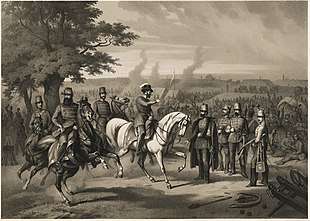
At 30 April 1849 he was named deputy War Minister substituting Görgei, who was leading the Siege of Buda (04-21 May 1849).[4] Quite in the first day in his office in Debrecen Klapka had a conflict with Sándor Petőfi, the Hungarian national poet, then a major in the Army of Transylvania under the command of Lieutenant General Józef Bem. The cause of the conflict was the article written by Petőfi in the newspaper Honvéd, in which he published a letter of Bem against general Károly Vécsey, accusing the latter of high treason, cowardice and incapacity, because he did not helped Bem in his failed attempt to capture the fortress of Temesvár.[16] Hearing about this Klapka and also other Hungarian generals, who were on Vécsey's side, accused Petőfi of being undisciplined, dressing not accordingly to a soldier, besmirching the Hungarian army to the public, thus weakening the will of the nation to fight against the enemy.[17]
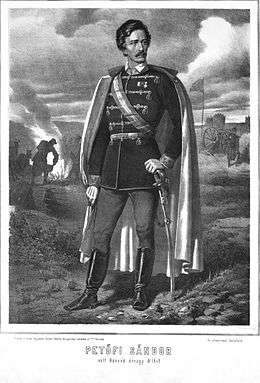
Klapka was angered on Petőfi also because the poet's former conflicts with other Hungarian officers and war ministers like Lieutenant General Antal Vetter and Lieutenant General Lázár Mészáros (against whom he wrote also a satirical poem), so he dumped on the poet, who came to the war office to ask for permission to go to the freshly liberated Pest, to bury his father. At the end of the quarrel, seeing that Klapka would not allow him to go, Petőfi declared that he resigns from his military title and quits the army.[18] After this, thinking that now he is liberated from all military discipline rules, Petőfi wrote a letter to Klapka, declaring that he cannot bear the offenses from Klapka, which offended his dignity, and wrote a poem entitled Egy goromba tábornokra (About a Rude General), in which he named Klapka an unworthy man and a weak general.[19] Klapka prosecuted Petőfi for this, and when he met him at 14 May at Pest, he arrested the poet.[19] Petőfi was saved by General Görgei, whose favorite poet he was, liberating him from the arrest, sending a deputation made of officers to ask for pardon from Klapka in the name of Petőfi.[19]
In the middle of May 1849, the news about the upcoming Russian intervention spread throughout Hungary, and the need to take measure against this grave danger, became imminent.[20] The enemy had a huge numerical advantage against the Hungarian army: the attacking Russian and Austrian armies had 358 000 soldiers (plus other 75 000 soldiers in Galicia and Walachia in reserve) and 770 cannons against 150 000 Hungarian soldiers with 440 cannons.[21]
In the second part of May, Klapka was designated to elaborate the united operation plan of all the armies from Hungary.[22] According to this operation plan the main army under Görgei had to defend the Western border, while the army of Transylvania under Józef Bem had to defend mountain passes in the Eastern Carpathians, but in the same time he had to crush also the Romanian revolt from the Western Carpathians, to take the fortresses of Gyulafehérvár and Déva, then to attack towards West, taking the Titel Plateau, liberating Pétervárad, then advancing to the Adriatic Sea, or to the Western front.[22] Although it was accepted by the Ministry Council from 20 May, this operation plan was met with harsh critics from Görgei and Bem, who accused it with no concern to the imminent Russian intervention which menaced from North and from East, and that Lieutenant General Bem and General Mór Perczel had been designated to carry out military actions which exceeded their capacities, while the other Hungarian corps were condemned to almost complete inactivity.[23] Bem declared that he will not carry out the military actions entailed on him by this operation plan, and he will remain in Transylvania to defend it from the imminent Russian attack, while Görgei said that the only correct thing to do in this grave situation, is to immediately attack with all forces on the Western front towards Vienna, to crush the Austrian army before the Russians could intervene.[23] As the result of these reactions and the start of the Russian intervention on 15 June 1849, the operation plan elaborated by Klapka was not carried out.[4]
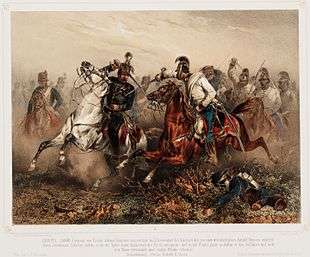
In June, when Görgei took over his duties in the War Ministry, Klapka substituted him in the command of the Army of the Upper Danube, being entrusted, together with the chief of the general staff Colonel József Bayer, to attack the imperial forces led by Field-Marshal Julius Jacob von Haynau in the region of the Vág river, and push them towards Pozsony and Vienna,[4] but at 16 June they were defeated by the Austrians in the battle of Zsigárd.[24] When Görgei took over the main command, in the Battle of Pered from 20–21 June 1849, Klapka had the mission to attack with the VIII corps the Austrians in the Csallóköz, but his troops were defeated at Nyárasd, and forced to retreat.[25] Nevertheless, at the end of the battle Klapka's troops secured the retreat of the Hungarian army, by securing the bridge from Aszódpuszta.[26]
During the Second Battle of Komárom of 2 July, Klapka commanded the left wing of the Hungarian army, retreating initially from Ószőny, but at the end of the battle, after fierce fighting, recaptured the important locality from the Austrian IV corps led by General Ludwig von Benedek.[27] At the end of this battle Görgei was heavily wounded, and once again, Klapka took over the command from him, until he was again able to lead the army.[4] During this period under the lead of Klapka, the Hungarian officers decided to oppose the decisions of the Hungarian government, which demanded the immediate retreat of the army from Komárom, and the deposition of Görgei from the commandment of the Army of the Upper Danube. Klapka and the officers refused to fulfill both these orders, forcing the government to accept their decision to remain for a several days in Komárom, and to keep Görgei as their commander.[28] At 11 July, because Görgei was still unable to lead the army, Klapka commanded the Hungarian forces in the Third Battle of Komárom. The Hungarians tried to break the Austrian blockade from the West against Komárom, but, because of the inactivity of two of the corps commanders, the battle was lost.[29]
Klapka's heroical "last man standing" as the defender of Komárom
On 12–13 July, when, under Görgei's command, the Army of the Upper Danube retreated from Komárom to the East Klapka remained with the II and VIII corps (around 18,300 soldiers) in Komárom, having the duty to defend with all cost the fortress and to "bind" as many enemy troops around it, preventing them to participate in the campaign against the Hungarian armies.[30]
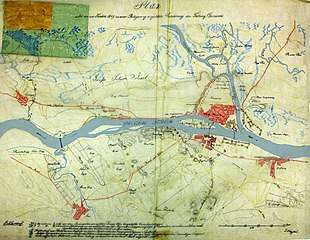
As the captain of the encircled fortress, cut from the other Hungarian armies, Klapka decided to do a heroical fight against the superior enemy, to resist until nothing can be done, and if he would be forced to leave Komárom, he would do it only with honor and head erect. He wrote this in July:
I say it already from now: no matter what will be the situation, we can leave this place only with honor, or we will be buried together under the crumbling ruins of this [fortress]. Long live the Fatherland, and its heroic army![31]
Until 23 July this task was fulfilled with success, forcing 28,000 imperial soldiers to secure the fortress, but then half of these troops were sent to Pest.[32] On 25 July a Hungarian raiding unit captured a stagecoach in which they found documents containing the list of the imperial troops around Komárom, from which Klapka understood that his troops from within the fortress are more numerous than the besiegers, and because the fact that the imperial troops were positioned on the both shores of the Danube, which prevented them to help each other when attacked, he had the opportunity to defeat the enemy in detail.[32][31]
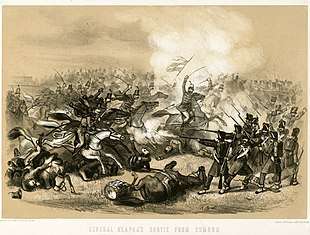
In the night of 29–30 June Klapka sent troops on the left bank of the Danube, chasing away the Austrian troops from the North-West of Komárom.[32] In the night of 3 August 1849, Klapka personally led the Hungarian troops to the right bank of the Danube, attacking the Austrian blockade around the fortress, crushing the imperial forces led by Lieutenant Field Marshal Anton Csorich in the Fourth Battle of Komárom, causing them 1500 casualties, capturing 30 cannons, many thousands of riffles, ammunition and an entire herd of oxen.[33] This was the last important battle won by the Hungarians in the Hungarian War of Independence.[34] After the battle Klapka's troops advanced towards West and occupied the city of Győr, liberating a huge territory from North Transdanubia, cutting the connection and supply lines between Vienna and the troops led by Haynau in Central Hungary.[34] Hearing the news of this victory the citizens of Székesfehérvár revolted against the occupying Austrian forces and chased them away.[35] Klapka started recruitment from the liberated territories, which added 5000-6000 new recruits to his troops, and planned to attack the Austrian province of Styria.[36]
But on 11 August he received news about the disastrous situation on the other fronts, and he halted his operations.[36] He understood that his victory came a little too late to change the fate of the Hungarian war of independence. Two days after this, at 13 August 1849, 10 days after Klapka's victory, the main Hungarian army led by Artúr Görgei surrendered in front of the Russian troops at the Szöllős Meadow near the village of Világos.[37]
Klapka, together with his 25,000 soldiers, retreated on 15 August to Komárom. On 19 August the Austrian and Russian troops arrived to the fortress and begun to encircle it, on 14 September the number of the Austrians reached 44,000 soldiers and 154 cannons,[36] and the Russians numbered 12 000 soldiers and 56 cannons.[31] The Austrians then the Russians too demanded the surrender of the fortress but Klapka and the Hungarian military council refused.[36] Thanks to the intervention in the negotiations of the Habsburg Minister of Defense Ferenc Gyulay, himself a Hungarian, on 21 August a 14 day armistice was signed, which allowed to Klapka to send four commissioners to travel across all Hungary to ascertain about the military situation in the country, and to be sure that the Hungarian army had lost the Independence War.[31]

After the commissioners turned back with the news of the surrender of the Hungarian armies and the majority of the fortresses, instead of deciding to surrender as well, like the Austrians and the Russians hoped, the defenders of Komárom became more combative and wanted even more than before, to continue their fight.[31] Klapka ordered new battalions and one division to be formed, and the trenches around the fortress to be strengthened. He even founded a personal guards unit made up of grenadiers.[31]
During the Austro-Russian siege the Hungarian composer Béni Egressy who was in the besieged Komárom, wrote the Klapka March, in honor of the general. This military march is played often also today during the military parades in Hungary.[2] The marchs lyrics, entitled Fel, fel vitézek a csatára (Rise, Rise Soldiers to the Battle) were written much later, in 1861, by Kálmán Thaly.[6]
At the end of August all of the mobile Hungarian troops surrendered, as well the fortresses too, with the exception of Pétervárad, which held until 7 September.[38] Only the fortress of Komárom refused to surrender. On 5, 7, 10, 25 and 27 September the Hungarian defenders fought with success against the enemy troops, furthermore the Hungarian Hussars executed successful sorties against the besieging army. For example, on 5 September 300 Hungarian hussars, led personally by Klapka, routed a Russian Cossack unit at Hetény.[31][39]
Seeing that they have no success in their attempts to take the fortress by force, the Austrians tried distraction, attempting to diminish the morale, fighting spirit and the unity of the defenders. They sent in the fortress different leaflets, fake reports, orders, which tried to persuade the defenders to treachery, to revolt, to refuse to fulfill the orders, or to desert, promising them amnesty in exchange.[31] This method had a certain success, because the number of the desertions increased, and Klapka was forced to take more drastical measures against them. As a result, 15 Hungarian deserters were executed publicly in the main square of Komárom.[31]
The Austrians even paid a hitman to assassinate Klapka. His name was Fehérhegyi, and allegedly he was born in New York. He was caught before he could assassinate Klapka. They found at him a letter of credence from the Austrian officer Lieutenant-Colonel Hoyos, which demonstrated that he worked for the Austrians. Fehérhegyi was sentenced to death by the martial court and executed.[31]
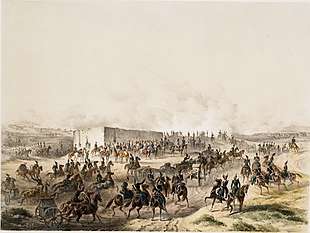
The Austrians continued to send demands to surrender, and on 19 September the Hungarian military council of Komárom decided to resume the talks with the Austrians.[31] Some of the officers were against this and conjured against Klapka, but they were caught and put to jail.[31] Klapka sent a demand to the besiegers demanding from the Austrians to give total amnesty for all people from Hungary, who participated in the revolution and in the War of Independence, and to liberate the war prisoners. Probably Klapka knew that these conditions could not be accepted, but he wanted to win time, hoping for a new Hungarian uprising or a foreign help. He also hoped that with these exaggerated demands he will be able to obtain at least amnesty for the defenders of Komárom.[31] This was rejected, Lieutenant Field Marshal Anton Csorich demanding unconditional surrender, so the Hungarians decided to continue the resistance.[2] On 26 September the main commander of the Austrian froces Julius Jacob von Haynau arrived to Komárom, took over the leadership of the besieging forces and ordered general attack against the fortress, but it was easily repulsed by the Hungarian artillery and a Hussar squadron.[40] This was the last military engagement of the Hungarian War of Independence of 1848-1849.[31]
Haynau understood that taking Komárom will be a very hard and very long task, and it will cause thousands of deaths among his troops, so he decided to seek a compromise with Klapka and the defenders.[31]
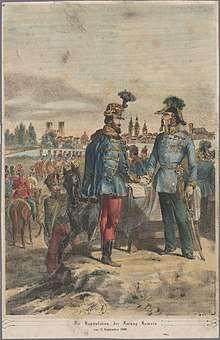
Finally on 27 September 1849 the delegation of the defenders agreed with Field Marshal Haynau about the conditions of the capitulation of the fortress. These conditions were as follows:
- The soldiers could leave without their arms, while the officers could leave retaining theirs;
- Those officers who prior to the Hungarian War of Independence were in the Austrian army, received passport to leave the country;
- Those who didn't wanted to leave, they could return home, without being prosecuted;
- Those Hungarian officers who prior to the war were not in the Austrian army could return home, they were free to work in any profession, start businesses, but they were prohibited to be conscripted in the army again;
- The former soldiers of the Habsburg armies received total amnesty;
- Those who wanted to leave the country, had to ask for passports in 30 days;
- The officers received payment for 30 days, while the simple soldiers for 10 days in Austrian banknotes;
- The vouchers used as money by the soldiers and the people of Komárom during the siege, will be redeemed in Austrian banknotes;
- The crippled, the sick and the wounded people and soldiers which were in the hospitals of Komárom will receive medical attendance;
- Everybody will retain their personalities and realties.[31]
The amnesty given by the Austrians regarded only the soldiers. But Klapka knew that the civilian people, intellectuals or politicians, who lived or retreated in Komárom, who participated in the Hungarian revolution and politics can be prosecuted by the Austrians after the surrender of Komárom. So he gave to all of them military certificates.[31]
Between 2–5 October 1849 Klapka surrendered the fortress to Haynau, with this ending the Hungarian War of Independence.[41]
On 2 October the Hungarian troops started to evacuate one by one the fortifications and different buildings of the fortress and the town. The soldiers formed lines before the Starfort (Csillagerőd), while the military orchestra played the Klapka March. Then came Klapka, who rode before their lines, then he stopped on the middle and said goodbye to them. Then the soldiers put their weapons in stacks, and took farewell from each other. At the end all of them received Geleitscheins (safe conduct papers), which assured for them their total freedom and immunity.[31]
At the end Klapka declared:
We had done what the human capacity can achieve, and we can stand before God's and the worlds court without shame[31]
Indeed, in the history of the 1848-1849 European revolutions only Komárom and Venice put their weapons down with such favourable conditions. The capitulation of Komárom was the last event from the Hungarian Revolution and War of Independence, and it was the last place in the European revolutions of 1848-1849, which ended the resistance against the united forces of the monarchies.[31]
So the capitulation of Komárom by Klapka was the last event of the European 1848-49 Revolutions.
Exile
Klapka left the country at once, and lived thenceforward for many years in exile, at first in England and afterwards chiefly in Switzerland. He became a Swiss citizen, he settled in Geneva and started to work in the finances.[6][2] He went to Istanbul, working at a bank.[3] He continued by every means in his power to work for the independence of Hungary, especially at moments of European war, such as 1854, 1859 and 1866, at which an appeal to arms seemed to him to promise success."[42] Using his international reputation as great Hungarian general, won in the press of the European countries became a sort of "wandering ambassador" of the Hungarian cause, trying to win supporters to start a new Hungarian freedom war.[2]
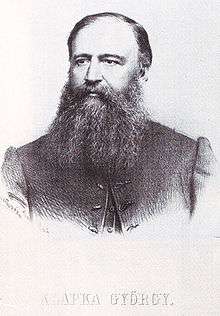
He tried to create an alliance with the states and nations which were neighbours with Hungary, like the Principality of Serbia or Moldavia and Wallachia, and supported the Polish Uprising of 1863–1864 against Russia.[2] In 1859, Alexander John Cuza, the first Ruler of the United Principalities of Wallachia and Moldavia, offered general Klapka military support asking for a favourable reconfiguration of other peoples' situation in the Habsburg Empire (including Romanians): "In May 1859 two agreements were signed between Alexandru Ioan Cuza and general Klapka, commander of the Hungarian revolutionaries, by which A.I. Cuza commits to obtain and provide weapons to Hungarian revolutionaries, helping them against Austria, at the same time setting the principles for reconciliation between the nationalities of Austria."[42] During the Crimean War (1853-1856), the Ottoman government wanted to appoint him as a commander of an army, but they renounced upon the protests of Austria.[2]
Hungarian corps
During the Second Italian War of Independence (1859) Lajos Kossuth signed an agreement with Napoleon III the emperor of France, to organize in Italy a Hungarian Legion from the Hungarian soldiers from Italy, which had to break in Hungary, and organize a rebellion there against the Habsburgs.[2] Klapka, who became a member of the Hungarian National Directorate (Magyar Nemzeti Igazgatóság), which was fulfilling the role of a Hungarian government in exile, was appointed to organize and then lead it.[6] But it wasn't Napoleon's interest to destroy the Habsburg Empire, so, after the Battle of Solferino he concluded a peace treaty with the Habsburgs, without asking the Italians or the Hungarians opinion.[2] As a result of this the Hungarian Legion disbanded, and Klapka protested against this by retiring.[2] He was more and more disappointed with Kossuth's role and activity in leading the fight for the Hungarian cause in Europe, believing that Kossuth's policy is condemned to fail.[6]
When the Austro-Prussian War from 1866 broke out, the Hungarian politicians and officers in exile agreed with the Minister President of Prussia Otto von Bismarck to form a Hungarian Legion, which had to fight against Austria, and start a national uprising in Hungary.[2] Once again Klapka was designated to organize a Hungarian corps in Silesia, and as major-general to lead it into Hungary.[2] He gathered 1500 soldiers, but when, at 3 August 1866 he entered in Hungary through the Jablonka Pass in Hungary, the fate of the war was already decided, and the Austrians and the Prussians concluded an armistice, so he lost the Prussian support.[2] Klapka was informed about the armistice when he was preparing to cross the Jablonka pass into Hungary, and the Prussians asked him to retreat, and stop his military actions. Klapka refused this and entered in Hungary, advancing until Turzófalva, but the Slovak population which lived there didn't wanted to join his troops.[6] Then Klapka's 1500 soldiers were met by much superior Austrian troops, which forced him to retreat.[2] Klapka protested against this by retiring, and once again, the Hungarian Legion was disbanded.[2]
Return
After the Austro-Hungarian Compromise of 1867 Klapka was permitted to return to his native country, but as well as in the case of Artúr Görgei, the emperor Franz Joseph I of Austria didn't allow him to join the army, because he didn't forgive his campaign attempt in Hungary from 1866.[2] As a result of this Klapka turned to politics, between 1868-1872 becoming member of the right wing Deák Party, being elected in the Hungarian Parliament as a deputy of Illava, then his hometown Temesvár.[2] He didn't spoke often from the pulpit, instead he edited a political magazine.[3] In 1868 he became the president of the associations of the Hungarian veteran soldiers of 1848-1849.[2]
After a while he retired from politics and tried his luck in economy, spending his time in Istanbul and Genoa, founding there businesses.[2][3]
In 1864 he married with the daughter of an English businessman, who settled in Brussels. Her name was Inez d'Arboin, they settled in France and had two boys and a girl: György, Ernő and Márta.[3] In this period Klapka spent much of his time in Cognac.[3]
From the 1870s, Klapka couldn't withstand to the homesickness, so he returned to Hungary.[3] He was celebrated by the crowd in Budapest and in other towns, he was offered to return in politics, but he refused, continuing to work in economy.[3]
In 1877 he tried to convince Hungary to open a war against the Russians to help the Ottomans.[3] During the Russo-Turkish War (1877–1878) he became a military counselor of the Ottoman army.[2]
In his last years he lived in the Crown Prince Joseph Hotel (József Főherceg Szálloda) from Budapest. He died on 17 May 1892 in Budapest. His coffin was escorted to the cemetery by a huge crowd singing the Klapka March.[2] The first handful of earth which was thrown on his coffin was taken from Komárom, the fortress which he defended so heroically in 1849.[2] He was buried in the Kerepesi Cemetery in Budapest.[3] A memorial was erected to his memory at Komárom in 1896 and the city's museum was named after him.[6]
Personal
Appearance and personality
He was slender, of medium stature, with an elegant, delicate appearance: his dark glossy, moony eyes showed a spirited, poetic personality, fiery bravery and seas of beautiful conceptions. His dark hair, cambering slightly on the high, delicate forehead, and his long dense black beard completed the nice, noble and manly face.
— Péter Szillányi, chief of Klapka's general staff[3]
Klapka's qualities, skills as military commander
Klapka had a high military qualification, he was a reasonable theorist and a great strategist, the military history being always his favourite reading. As commander we can hold only one flaw against him: that he was still too young, and because of this he had many fantasies, which error ameliorated day after day.
— Péter Szillányi[3]
Klapka was one of the most genius commanders, having higher military culture, to which he could add wordly culture too. He was a good general and he excelled with high military ideas, but moreover he was the man of the sentiments, in contrast with Görgei's rigid strong-mindedness. In his personal relations, as a soldier, although he was inclined to follow Görgei, but he was a better patriot, than to refuse to cooperate with the government. But this relation often paralyzed his capacity of decision. He was a chief too humane, and besides an excellent brother in arms. He was the enemy of any violence, and if in critical situations he had to show hustle, he was able to show his humanity also in these cases.
— Richárd Gelich, officer, military historian and theorist[3]
Author
He wrote the following works:
- Memoiren von Georg Klapka (April-October, 1849.). Mit einem Anhange, die historischen Actenstücke enthaltend, dem Porträt des Verfassers, einer Karte von Ungarn und dem Plane des Kriegsschauplatzes in Komorn. Leipzig, 1850 (in German) (full text)
- Der Nationalkrieg in Ungarn und Siebenbürgen in den Jahren 1848 und 1849. Mit einer Karte von Ungarn. Leipzig, 1851 (in German) (full text)
- Der Krieg im Orient in den Jahren 1853 und 1854 bis Endre Juli 1855. Eine historisch-kritische Skizze der Feldzüge an der Donau, in Asien und in der Krim, mit einem Blick auf die mögliche Wendung der künftigen Kriegsereignisse. Geneva, 1855. (in German) (full text)
- The eastern question. Translated from the German, with a preface and appendix by Humphry William Freeland. London. (1877)
- Emlékeimből Függelékül: gróf Teleki László levelei. Bpest, 1886. arczk. Bud. Szemle XLV. 1886 (in Hungarian) (full text)
Here were mentioned only the original editions in the language in which Klapka wrote them. These books were translated very quickly in English, French, German and Hungarian.
Besides of these he wrote many articles in Hungarian and foreign newspapers and magazines, like : La Presse from Paris, Independence from Bruxelles, and Pesti Napló, Századunk, Honvédmenház Könyve, Pesti Hirlap, Nemzet, Budapesti Szemle, Ország-Világ, all these Hungarian newspapers and magazines.[3]
Legacy
As mentioned before, in 1849, Béni Egressy wrote the Klapka March to honor Klapka as a great commander and Hungarian patriot.
The writer Jerome Klapka Jerome, best known for Three Men in a Boat, was named after him by his father who was impressed by György Klapka's reputation as a great general and patriot, when the latter was spending his time in Great Britain.[43]
References
- Obituary, New York Times, May 18, 1892 p. 4
- Zsolt Vesztróczy 125 éve hunyt el Klapka György, Komárom hős védője , (2017)
- Szinnyei József: Magyar írók élete és munkái VI, Klapka György (Móricz) Budapest, 1899
- Bona Gábor Tábornokok és törzstisztek az 1848/49. évi szabadságharcban , (2015)
- Tarján M. Tamás / 1820. április 7. Klapka György születése Temesváron, Rubicon. (2010 VII/11)
- "Híres Komárom" védője, (2015)
- Hermann 2004, pp. 139–146.
- Hermann 2004, pp. 155–162.
- Hermann 2004, pp. 216–217.
- Hermann 2004, pp. 201.
- Hermann 2001, pp. 273–275.
- Hermann 2004, pp. 227.
- Hermann 2001, pp. 268.
- Csikány 2015, pp. 49–50.
- Bánlaky József: A magyar nemzet hadtörténete XXI, A Komárom felmentését célzó hadműveletek (1849. április elejétől végéig). Arcanum Adatbázis Kft. 2001
- Kerényi 2008, pp. 442.
- Kerényi 2008, pp. 442–443.
- Kerényi 2008, pp. 444.
- Kerényi 2008, pp. 445.
- Hermann 2001, pp. 315.
- Hermann 2001, pp. 318.
- Hermann 2001, pp. 316.
- Hermann 2001, pp. 317.
- Hermann 2001, pp. 366.
- Hermann 2004, pp. 281.
- Hermann 2004, pp. 282.
- Csikány 2015, pp. 162–180.
- Hermann 2001, pp. 351.
- Hermann 2004, pp. 306–312.
- Hermann 2001, pp. 394–395.
- Zsolt Kántor Az 1848-1849-es forradalom és szabadságharc epilógusa a komáromi erőd kapitulációja , (2016)
- Hermann 2001, pp. 395.
- Hermann 2001, pp. 396–397.
- Hermann 2001, pp. 397.
- Hermann 2004, pp. 360.
- Hermann 2001, pp. 398.
- Hermann 2001, pp. 389–390.
- Hermann 2001, pp. 394.
- "1848-1849 Hadi események (1848-1849 Military Events)". Archived from the original on 9 October 2015. Retrieved 9 July 2019.
- Bánlaky József: A magyar nemzet hadtörténete XLIV, A komáromi események. 1849. július közepétől október elejéig.. Arcanum Adatbázis Kft. 2001
- Hermann 2001, pp. 399.
- C.C. Giurescu (ed.), 1972, Romania's History in Data, Bucharest, Romanian Encyclopedic Publishing, p. 207
- Bălan Titus Ce legatură are casa Klapka din Cetate cu Jerome K. Jerome și Revoluția din 1848 , (2017)
Sources
- Bánlaky, József (2001). A magyar nemzet hadtörténelme (The Military History of the Hungarian Nation) (in Hungarian). Budapest: Arcanum Adatbázis.
- Bona, Gábor (2015). Tábornokok és törzstisztek az 1848/49. évi szabadságharcban (in Hungarian). Budapest: Nemzeti Kulturális Alap.
- Csikány, Tamás (2015). A szabadságharc hadművészete 1848–49 ("The Art of Warfare in the War of Independence of 1848–1849") (in Hungarian). Budapest: Zrínyi Katonai Kiadó. p. 380. ISBN 978-963-327-647-1.CS1 maint: ref=harv (link)
- Hermann, Róbert (2004). Az 1848–1849-es szabadságharc nagy csatái ("Great battles of the Hungarian Revolution of 1848–1849") (in Hungarian). Budapest: Zrínyi. p. 408. ISBN 963-327-367-6.
- Hermann, Róbert (2001). Az 1848–1849-es szabadságharc hadtörténete ("Military History of the Hungarian Revolution of 1848–1849") (in Hungarian). Budapest: Korona Kiadó. p. 424. ISBN 963-9376-21-3.CS1 maint: ref=harv (link)
- Kerényi, Ferenc (2008). Petőfi Sándor élete és költészete ('The Life and Poetry of Sándor Petőfi) (in Hungarian). Budapest: Osiris Kiadó. ISBN 978 963 389 983 0.
- Pusztaszeri, László (1984). Görgey Artúr a szabadságharcban ("Artúr Görgey in the War of Independence") (in Hungarian). Budapest: Magvető Könyvkiadó. p. 784. ISBN 963-14-0194-4.CS1 maint: ref=harv (link)
- Tarján M., Tamás (2010), "1820. április 7. Klapka György születése Temesváron (7 April 1820. The Birth of György Klapka in Temesvár)", Rubicon. 2010 September
- Vesztróczy, Zsolt (2017), "125 éve hunyt el Klapka György, Komárom hős védője (Komárom's Hero Defender Died 125 Years Ago)", ujszo.com 21 May 2017